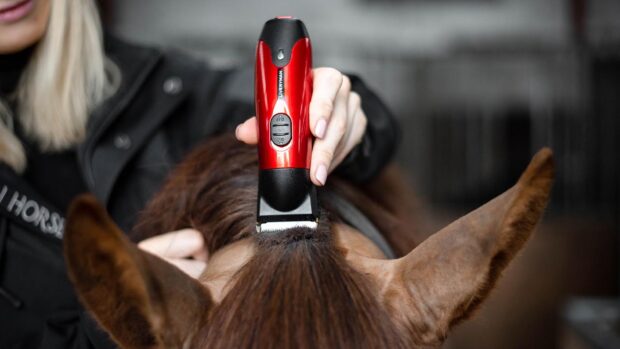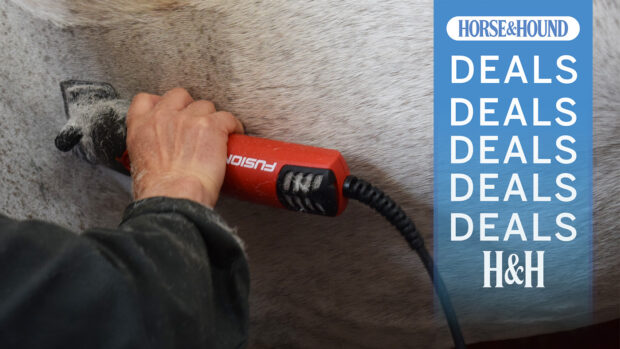Jason Webb of Your Horsemanship is a UK-based Australian horse trainer with a passion for starting young horses, solving equine problems and teaching riders of all abilities how to strengthen the partnership they have with their horses. Here Jason gives one horse owner advice on clipping a horse that is not keen on the process
Q: My horse dislikes being clipped and won’t stand still – “I have been avoiding clipping but with two native types that both get sweaty walking around the block and a hunter trial coming up, it has to be done. My Welsh is the problem. I’ve had him since he was a youngster — he’s lived a lovely life and he was bought him up with the clippers nicely — they were never was a problem. I used to clip just his belly loose in the stable as a three-year-old to get him used to it. I gave him a few treats, he liked it, then I progressed to a bigger clip the more work he was in.
“The older he’s got, the worse he’s become with clipping. Now as soon as I turn the clippers on, he runs back like a wild animal and his eyes pop out his head. He won’t ever kick or rear, but he won’t stand still. They are the same clippers I’ve always used and my other horse doesn’t have a problem, but he’s an out and out drama queen (he’s the same with every aspect of life).
“I really don’t want to pay for him to be sedated — do you have any ideas on how I can fix this? I’d leave him unclipped, but we have two fun rides coming up and he’ll get far too hot in his winter woollies!”
Jason Webb answers – This horse sounds like a natural worrier, which means it might only take the clippers or trimmers to pinch once or for someone to approach him differently or a little quickly to make him become suspicious. You will have to go back to the start with this horse. This means ensuring your groundwork is solid and that you are confident with the desensitising process before you even attempt to bring the clippers near him but it will be time well spent!
Before introducing the clippers, your basic groundwork must be good enough to enable you to place your horse where you want them to stand. This is key as a horse that is running all over you and who does not respect your space or have confidence in you will not cope well when you start desensitising work with them.
You need to be able to back them up, lead them forward, and move their shoulders, ribs and hindquarters to each side independently of each other. There are some simple exercises you can do to install this basic groundwork and this will help you managing your horse in everyday situations and are worth putting some time into. I recommend a rope halter and 12ft lead rope for this type of work. Once your groundwork is good enough you will be able to keep repositioning your horse easily and with minimum fuss.
The second process to go through with your horse is desensitising them to the clippers and the noise. I tend to start with other objects such as plastic bags and a bottle with some rocks in it with the aim of being able to move it all over their body. The head, ears and legs are the most sensitive areas of a horse so make sure they are confident with contact on their body before progressing to these parts. Should you find a sensitive area, try to stay where you are until your horse stops moving and relaxes, then remove the touch or noise. This rewards your horse for stopping and standing.
When you have been through the desensitisation process with a range of objects, you can try an electric toothbrush or similar device that makes a noise like clippers but on a smaller scale. Check out the clipper app online if you don’t want to use your toothbrush! You can then move on to the clippers themselves – start with them turned off, then move on to them turned on but with your hand between them and your horse. Work progressively until your horse is able to stand relaxed with the clippers making contact with their body. Only once you reach that point should you try removing any hair.
Here is a video that might help: yourhorsemanship.com/clipping-exercise/
For more information on Jason Webb and his online training base Your Horsemanship, where you can learn a foundation in horse training with online lessons in groundwork, starting, and ridden fundamentals, among other topics, visit his website
- To stay up to date with all the breaking news throughout Horse of the Year Show, London International and more, subscribe to the Horse & Hound website
You may also be interested in:

Best horse clippers for taming every type of winter coat

8 trimmers for tidying, blending and finishing touches

Which type of clip is right for your horse? Check out H&H’s helpful guide

How to clip a horse: a video masterclass

Subscribe to Horse & Hound magazine today – and enjoy unlimited website access all year round




